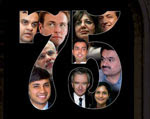The Star-Balaji affair has ended. Ekta Kapoor will have to rejig her plans
Till some time ago, the mirror on the Indian teletube wall always said that Ekta Kapoor’s K-recipe was the fairest of them all. But times have changed. Falling TRPs of her ace serials are leading many to conclude that the charm of Balaji’s kitchen-politics was wearing off. So now when we hear that Star Network and Balaji Telefilms Ltd. have broken their 2007 JV to launch regional channels together, the development demands attention. What’s more, Star has also announced an exit for its 25.99% stake in Ekta Kapoor’s production house, valued at Rs.1.23 billion. Clearly, something is brewing.
Says R. Karthik, CEO, Balaji Telefilms: “It was an investment which has been called off. It was a strategic move which had to be realigned.” But this tragic love story would certainly hurt Balaji, at least in the short run. For one, a majority of Balaji’s revenues were coming from Star, thanks in part to the prime time exclusivity agreement that the two shared. Balaji currently airs six shows on STAR Plus and derives around 65-70% of its revenues from the channel.
On its part, Star has nothing to lose from this break-up. “There are multiple content providers in the country, from which content can be sourced anyway. Moreover on the competition front, while Star faces intense competition in the GEC domain, it continues to maintain its strong market leadership with GRPs in excess of 300,” asserts Salil Pitale, Head-Media & Telecom, Enam Securities.
And although Star CEO Uday Shankar says that the “relationship between Star and Balaji as broadcaster and content provider will not be affected,” fact is that the end of their contract allows Star to re-negotiate the premium rates it pays to Balaji. Given that Ekta’s soaps are no longer ruling the charts – Bidayi, Star’s highest TRP grosser in recent times is not a Balaji production – the respite for Star will come in the form of not shelling out premium rates to the under-performing production house. In fact, 2009 may turn out to be an immensely challenging year for Balaji, as the production company has also launched a very high production cost shows - Mahabharata - and in the absence of premium revenues from cash cow Star, its margins are likely to be impacted.
However, all is not so bleak as it sounds. There are some positives for Balaji too. As per Angel Broking, Balaji will post a CAGR of 12.5% and 10.35% in consolidated top line and earnings driven largely by volume growth. Counting on such numbers even Jagat Dave, Director- corporate finance of Ambit Corporate Finance (exclusive financial advisor to Balaji) asserts, “Balaji Telefilms is a cash-rich company having around Rs.2.2 bn of cash reserves, as on March 31, ‘08, and it continues to evaluate various strategic opportunities in the Indian Media & Entertainment industry.” In the current scenario, wherein all broadcasters are vying with each other for premium content, Balaji Telefilms, with its track record is uniquely positioned to cater to this demand. Rumour has it that Anil Ambani’s ADAG may be up there in the race to net Star’s abandoned equity. Confirms a source in ADAG: “Yes, we are definitely looking out for production houses to add synergy to our channels and Balaji’s stake would definitely provide an edge to us.” And why not! This step by the company will provide aid to ADAG, as it plans to launch 20 channels to supplement its DTH venture (Big TV) and this deal will provide them an exclusivity of content to their channels.
If Anil Ambani’s ADAG hops on board, Balaji will certainly be able to tide over this unique quagmire that it finds itself in. And not to forget, the leading lady of Hindi soaps may still be able to make good on her dream to rule the regional content space.
Neha Saraiya
For more articles, Click on IIPM Article.
Source : IIPM Editorial, 2008
An Initiative of IIPM, Malay Chaudhuri and Arindam chaudhuri (Renowned Management Guru and Economist).
For More IIPM Info, Visit below mentioned IIPM articles.
IIPM Programme :- SUPERIOR COURSE CONTENTS
Now IIPM's World-Class Education... for everybody!!
IIPM INTERNATIONAL - NEW DELHI, GURGAON & NOIDA
IIPM - Admission Procedure
IIPM, GURGAON
IIPM : EXECUTIVE EDUCATION
IIPM’s 36th Glorious Year of Academic Excellence
4Ps Power Brand Awards 2007
When IIPM comes to education, never compromise
Why Study Abroad When IIPM Gives You 3 global Advantages!
IIPM Ranked No. 1 B-School In Global Exposre - Zee...


